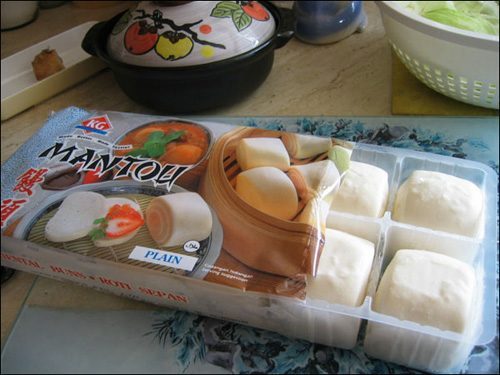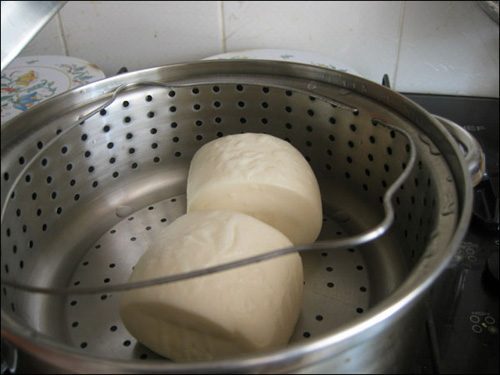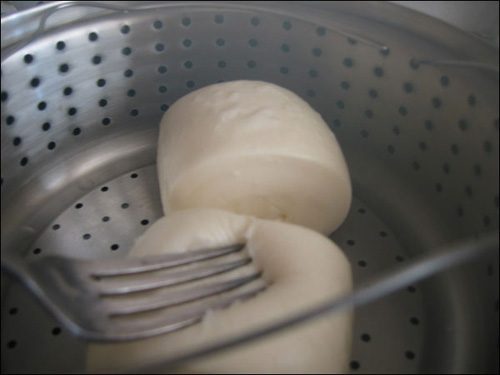The beginnings of my fascination with cooking. Mantou were my favourite after school snack, sometimes often doubling as a late brunch if I was in a lazy mood. If I was in a super lazy mood, I would run the frozen mantou under water then microwave for a minute on high instead of steaming as shown below.
For some inexplicable reason, this post has been one of the most popular. One commenter even contributed a recipe for making mantou from scratch along with a story about its origins. I subsequently found a Youtube video which shows the process in greater detail.
Originally posted on Mon, 25 April 2010 at 14:24 while listening to “Sky High” OST ‘Dance Dance Revolution’ and feeling filled.
Method
- Here we see our mantou in their natural environment. You can capture them from any freezer in your local asian grocery store.
- Place them into a steaming pot. Remember to put water inside the pot, otherwise it won’t steam but bake instead! It is also not very good for your pot to have no water in it because then you’re not letting it fulfil its life’s purpose.
- Light the stove and turn it up to the max so we can steam the mantou faster. Set the timer to around 12-15 minutes and in the mean time, eat some cookie egg rolls. I particularly like the Wing Wah brand.
- Check your mantou to make sure they’re steaming right.
- You can tell if they’re done when they’re really soft but firm – kinda like an elastic white sponge. Use a fork or chopsticks because they’re in a steaming pot and steam is evaporated water which means it’s hotter than 100 degree celcius so don’t use your fingers, silly.
- Tada! Of course, using a fork doesn’t give the greatest presentation results – if you want them to look pretty, use your fingers, duh.
Taste Evaluation:
Yummy! Nice and soft, just like they’re meant to be. If your mantou tastes like a rock or baked bread, then you left it in the steaming pot for too long, or you were a lazy bum who ran it under water for 2 minutes and then microwaved it and hoped that would work out.
Overall rating: 10/10
Commentary
fillee @ 15:21, Sun, 03 September 2006:
how to make mantou
1 tablespoon yeast
1 tablespoon Sugar
1 1/2 cups warm water
4 cups all-purpose flourIn a small bowl, sprinkle yeast and sugar over 4 tablespoons of the warm water and leave it for 15 minutes.
Place the flour in a bowl and make a well in the center.
Pour in the yeast mixture and the remaining water.
Mix everything to dough.
Turn it onto a floured board and knead until smooth.
Return dough to the bowl, cover and let it stand in a warm place for about an hour or until doubled in size.
Punch down, cover again and let it stand for 20 minutes longer.
Knead the dough again and shape into rolls.
Bring the water in the bottom of a steamer to a boil.
Place the rolls in the steamer, leaving a 1- inch gap between them.
Cook for 10 minutes or until firm and cooked through.
Serve them hot.you can also deep fry the mantou
enjoylittle fact about mantou
There is a saying that the Chinese word mántóu (饅頭) actually originated from the word 蠻頭 (lit. barbarian’s head), which has the same pronunciation in Chinese.
This story originates from the Three Kingdoms Period, when Zhuge Liang led the Shu army in an invasion of the southern lands (roughly modern-day Yunnan and northern Burma). After subduing the barbarian king Meng Huo, Zhuge Liang led the army back to Shu, but met a swift-flowing river which defied all attempts to cross it. A barbarian lord informed him that, in olden days, the barbarians would sacrifice 50 men and throw their heads into the river to appease the river spirit and allow them to cross; Zhuge Liang, however, did not want to cause any more bloodshed, and instead ordered buns shaped roughly like human heads – round with a flat base – to be made and then thrown into the river. After a successful crossing he named the buns “barbarian’s head”, or mántóu, 蠻頭 , which evolved into the present day mántóu (饅頭).






